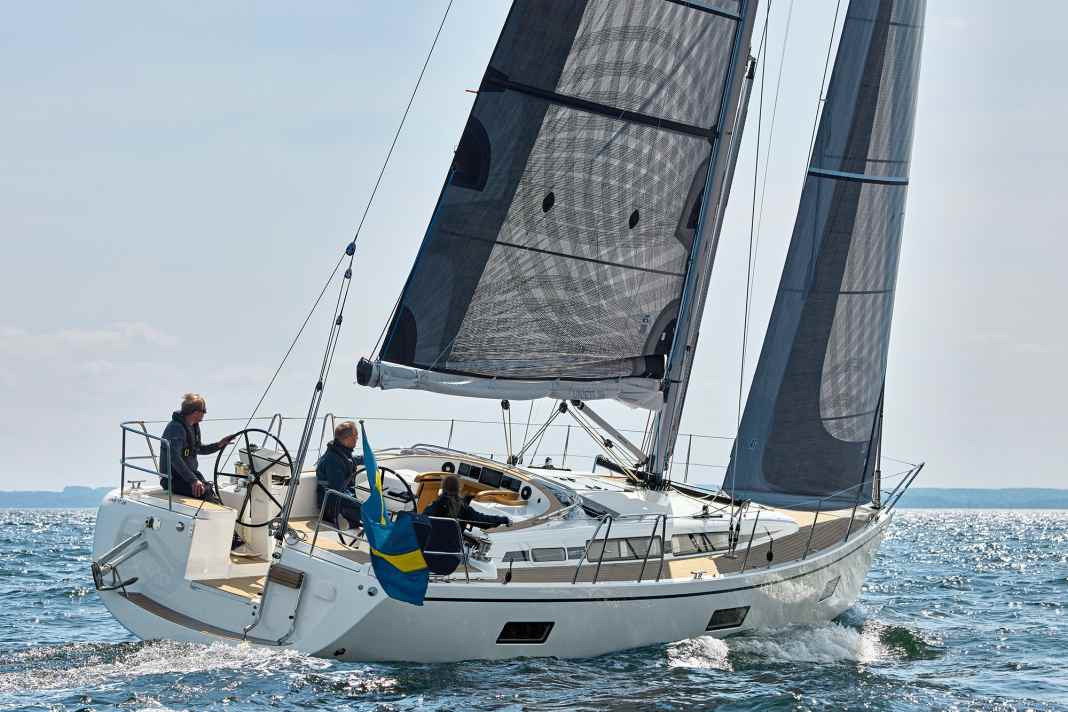





Europe's yacht of the year in the cruising yacht category. Here is the complete test.
Even if the timelessly understated lines do not suggest it, the Linjett 39 is something of a turning point for the shipyard from the northern Stockholm archipelago.
Not that the Swedes have suddenly abandoned the concept of high-quality, good and easy-to-sail cruising boats, quite the opposite. Even at first glance, it is clear that the GRP and woodworking are among the best the market has to offer. Nevertheless, the Linjett is fundamentally different from her older sisters because, as has long been the case elsewhere, she is computer-designed. Strange as it may sound, this approach is almost like a revolution for the family business. Previously, the yachts were developed by the senior Mats Gustafsson using wooden models, as was the tradition in the past. A prototype was then built and sailed by the family and optimised until the moulds could be approved for series production.
The Linjett has a racer feel
In fact, there is still a hand-built 1:10 scale model of the hull of the Linjett 39, but instead of taking the measurements for the prototype, it was digitised and further developed in Oscar Södergren's computer. This is basically due to the Shogun project. The radical carbon fibre racer is the brainchild of Håkan and Oscar Södergren. "We learnt a lot from building it, which was also incorporated into the design of the 39, which was developed in parallel," says project manager Daniel Gustafsson. One of the points that would not have been possible without load and laminate calculations concerns the fuselage structure.
Thanks to the solid floor assembly and additional longitudinal beams, the main bulkhead could be moved forwards, creating more space in the saloon. The CNC-milled foam core also comes from the construction of regatta yachts. The precise fit of the parts prevents gaps and cavities that would fill with resin during the infusion process, saving material and ultimately weight, which is also reflected in the displacement of 8.7 tonnes. Although this does not make the Linjett a racer, it is around 1.3 tonnes lighter than a similarly sized Hallberg-Rassy 39, and even an Arcona 410 is in the same league, as it gains its weight advantage from 900 kilograms less ballast.
Tradition meets innovation: the Linjett 39 has the best of both worlds
In addition to the design process, the 39 also breaks with other Linjett characteristics. The freeboard and volume are significantly larger than previous models. This is particularly noticeable in comparison to the much longer Linjett tested in YACHT 7/2018. Linjett 43 which offers hardly any more space below deck. At the same time, the draught increased to over two metres. This mark was previously considered particularly critical by the shipyard, as too much draught interferes with the typical Swedish mooring on the rocks. Despite the increase in volume, the 39 is one of the more graceful yachts in the harbour, as was demonstrated at its German premiere at the Ancora Yacht Festival. Alongside 40-footers such as the Hallberg-Rassy 400 or one X 4.3 the Linjett appears almost graceful.
The manoeuvrability of the Linjett 39 is impressive
This impression is reinforced as soon as you stand at one of the two steering wheels. The boat reacts incredibly directly, but never nervously. Even when manoeuvring in the harbour, it is noticeable that the rudder and keel are well coordinated. The L-shaped keel has a comparatively wide fin, so the dreaded drifting at slow speeds does not occur.
The test boat was also equipped with the V-Docker system from Vetus. The transverse thruster and engine are controlled via a joystick so that the yacht can be moved in any direction and turned on the spot. The four-cylinder Volvo engine is very well insulated and dimensioned. At full load, 8.5 knots are possible. The cruising measurement showed 7.3 knots at 2,250 rpm.
The Linjett 39 is suitable for single-handed use
The deck layout is also designed for comfort and single-handed operation. Halyards, sheets and outhauls run to four Andersen winches positioned in front of the wheels. A solution that has been used by Linjett for around 20 years and has been continuously refined. With a larger crew, however, the extreme concentration of the trimming devices requires planning so that you don't get tangled up in the manoeuvre - there are ten lever clamps per side. Stowage boxes integrated into the coamings swallow up excess rope and help with essential tidying.
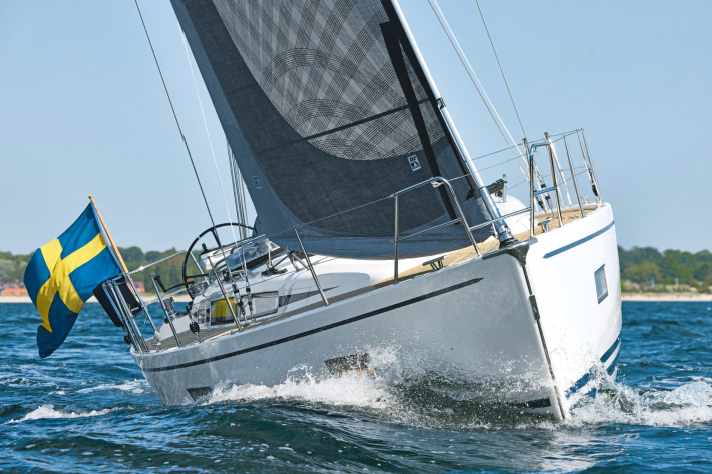
Well thought-out details, already included in the basic price
In order to minimise the friction of the long, concealed line paths from the mast to the steering wheels, the shipyard uses plastic tubes laid in large radii, which ensures comparatively smooth running. The rest of the fittings from Seldén and Lewmar are also of high quality and well dimensioned, and everything is easy to operate. Nothing pinches or jams.
We were sailing with the standard rig of mainsail and 107 per cent jib, which was enough to get the 8.5 tonnes of displacement going even in winds of only eight to twelve knots. In addition to the excellent X-Drive carbon sails from UK Sailmakers, the generous foresail triangle is responsible for this. The mast is positioned relatively far aft. This means that the size of the jib corresponds to that of the 43-foot sister model, so that we hardly missed the Code Zero, which was not yet ready for testing.
The only thing missing was a suitable sail for the room sheet, as neither a gennaker nor the spinnaker that was actually planned were on board. Contrary to the trend, the shrouds do not touch the side of the boat, so theoretically an overlapping genoa can also be used. However, corresponding rails are not provided and are hardly necessary given the sailing performance on offer. On the cross, we achieved an average of 6.4 knots with a true wind angle of 43 degrees. For a cruising boat and the low wind speed, these are very solid values. During the tests for Europe's Yacht of the Year (the Linjett 39 is nominated in the cruising yacht category), our colleagues achieved 7.1 knots in twelve knots of wind and the same angle of incidence. Even more impressive than the pure speed values is the steering behaviour; the Linjett sails extremely harmoniously. The deep-reaching rudder provides just the right amount of feedback, making it very easy to steer the boat on the wind edge and realise its potential.
The interior is well thought out down to the smallest detail and the build quality is impressive
In addition, the boat reacts much more agilely than the seemingly conservative lines would suggest; the smallest steering movements are enough to keep it on track. All in all, an excellent mix of sporty and comfortable.
The good forward visibility is striking, the body is flat and the cockpit floor behind the wheels is slightly raised. This creates two steps that have to be negotiated when changing from one side to the other. However, you soon get used to these.
The helmsman lacks a footrest when the boat is in an elevated position, in which case it is better to slide in front of the wheel and use the steering column as a support. The advantage of this position is that you also have access to the sheets and winches. The small overlap of the headsail ensures short sheet travel anyway, and the sail can also be used as a self-tacking jib when slightly furled; the necessary track is provided as standard.
Modern and cosy- the Linjett 39 inside
The positive impression continues inside. Even the retractable bulkhead is a sight to behold; thanks to the gas pressure spring, it is weightless and can be parked in any position. Anyone passing through the easily accessible companionway enters a modern yet incredibly cosy interior. Light oak veneer or classic mahogany are available as standard.
The quality of workmanship is more than impressive and literally tangible, whether it's the leather-covered stainless steel handrails, the laminated coamings and edge banding or the flawless paintwork. A look behind the scenes is also a real pleasure: you will look in vain for rough, unsealed cut edges, hooking fittings or creaking floorboards on the Linjett. Instead, there is mortised gluing and perfectly harmonised grain patterns. There are even inconspicuous details such as small additional latches to secure the refrigerator doors.
The volume is also noticeable: in the fore and aft sections, the 39 offers even better berths than her larger 43-foot sister. The layout of the heads is ideal for Nordic sailing areas. The shower is located separately opposite the galley, so it can be used as a drying room for oilskins.
Like many other things, the necessary heating is part of the standard equipment. This drives up the basic price, but fits in with the shipyard's claim to offer an all-round carefree package. On request, the boat even comes with a berth and full service for winter storage. The only downer apart from the necessary investment is that anyone who decides on a Linjett today will not be able to sail it until 2024 at the earliest - at least the shipyard guarantees the prices until then.
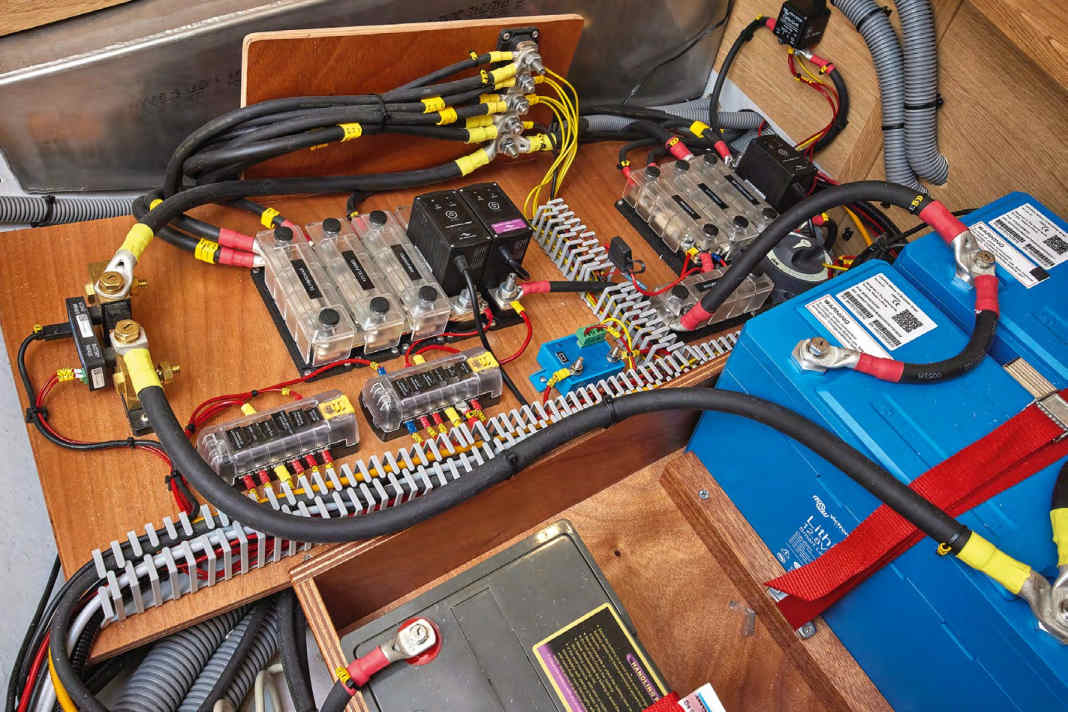


The Linjett 39 in detail
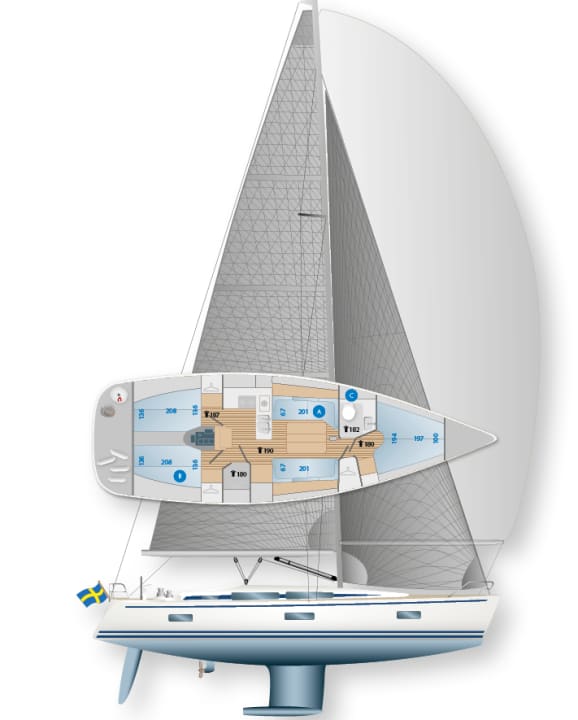
- Moderate rigThe bridge clearance height is less than 19 metres. Thanks to the long boom, the large vessel still has plenty of space
- Aft chamberAt 1.36 metres, the bunks are not very wide, but they are rectangular
- No noseThere is no gennaker nose. The sail is travelled on one eye on the bow
- Below deckTwo or three compartments, the layout is variable. The Linjett has two aft cabins as standard. However, owner's wishes can be realised, for example an aft cabin, one or two WCs or two showers. There is a choice of oak or mahogany for the interior
- Storage spaceAll compartments are fitted with large lockers and many cupboards. On deck there is a large stern storage space and a spacious sail locker behind the anchor locker
- RefrigeratorsThe pantry is equipped with two fridges, the upper one holding 42 litres and the lower one 75 litres
- TanksA Fresh water, B Diesel, C Faeces
- Deep rudderThe rudder blade is comparatively large, so the steering reacts very directly
- Two keel variantsThe standard draught of the lead keel is 2.15 metres. A 1.95 metre version is available as an option
Technical data Linjett 39
- Design engineer Linjett/Södergren Yacht Design
- CE design category A
- Hull length 12,15 m
- Total length 12,15 m
- Waterline length 11,03 m
- Width 3,95 m
- Draught/alternative 2,15/1,95 m
- Mast height above WL 18,7 m
- Theor. torso speed. 8.0 kn
- Weight 8,7 t
- Ballast/proportion 3,5 t/40 %
- Mainsail 52,9 m²
- Furling genoa (107 %) 38,0 m²
- Machine (Volvo) 37.5 kW/51 hp
- Fuel tank 200 l
- Fresh water tank 350 l
- Holding tank 100 l
- Batteries (LiFe4) 2x 200 AH
- Batteries (AGM) 90 AH
- Hull and deck constructionFoam sandwich built with vinyl ester resin using the vacuum infusion process. Bulkheads and deck connection glued and laminated
Sailing performance Linjett 39
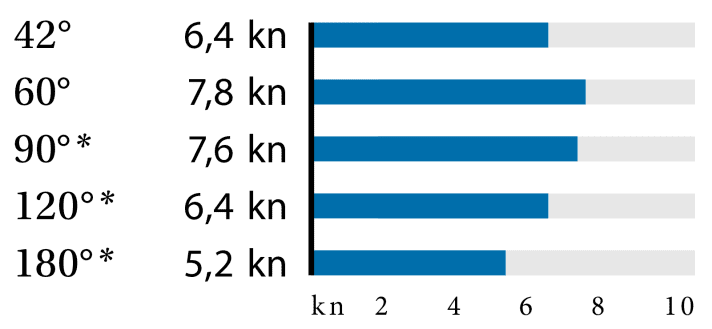
Linjett 39 potential

Noise measurement Linjett 39
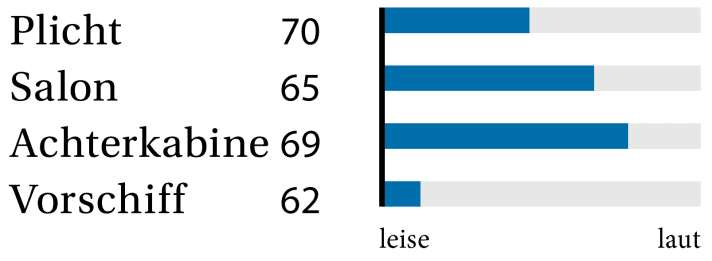
Equipment and prices Linjett 39
Base price ex shipyard 465.700 €
- Standard equipment included:Engine, sheets, railing, position lanterns, battery, cushions, galley/cooker, bilge pump, toilet, sail cover, anchor/chain, fenders, mooring lines, fire extinguisher, electric cooler, holding tank with suction, antifouling, clear sailing handover.
- For an extra charge: Sail (main and genoa) € 16,496, compass € 483
Price ready to sail482.679 €
- Guarantee/against osmosis 3/3 years
- Surcharge for comfort equipment
- Line adjustment hole points ---
- Traveller with line guide incl.
- Electric windlass € 10,567
- Tube kicker incl.
- Backstay tensioner incl.
- Jumping cleats incl.
- Sprayhood incl.
- Flexiteek in the cockpit incl.
- VHF radio € 2,652
- Log and echo sounder € 2,644
- Wind measuring system incl.
- Autopilot € 8,192
- Charger € 1,468
- Shore connection with RCD € 2,368
- 230-volt socket outlet (one) incl. €
- 12-volt socket in the sat nav € 209
- Heating incl.
- Pressurised water system incl.
- Hot water boiler € 2,869
- Shower WC room 150 €
- Cockpit shower with hot water.
Comfort price 513.798 €
- Electric bow anchor: At over 10,000 euros, the electric anchor windlass is enormously expensive, but it is a complex mechanism that automatically extends the bow anchor by remote control
- PackagesThe shipyard equips the boats individually, there are no fixed packages. Some options are usually bundled, for example the cockpit shower is included with the boiler
- Deck equipmentMost of the fittings are from Seldén. The halyard stoppers are from Lewmar. The self-tailing winches are from Andersen and are very well dimensioned
- Rig and sailThe rig is made of aluminium and comes from Seldén. Sails are not standard, the shipyard works together with UK Sails and offers high-quality X-Drive carbon sails
- Motor and gearboxThe standard engine is a Volvo D2-50 with 50 hp, saildrive and three-bladed folding prop. The cruising speed is 7.3 knots, with the engine consuming around four litres of diesel per hour
- Shipyard and distributionLinjett Yachts, Rosättra Varvsväg 57, 76176 Norrtälje/Sweden; www.linjett.se
YACHT rating
The new Linjett 39 is a cruising boat par excellence. Its superior sailing characteristics are inspiring. It also offers a quality of workmanship that is unrivalled in this size segment
Design and concept
- + Generous amount of space
- + Very solid structure
- + Highly customisable
Sailing performance and trim
- + Very good steering behaviour
- + Good crossing properties
- + Optimised for small crews
Living and finishing quality
- + Excellent workmanship
- + Plenty of well-organised storage space
- + Seaworthy detailed solutions
Equipment and technology
- + Well dimensioned fittings
- + Very clean installation
- + Pleasingly comprehensive basic equipment
This might also interest you:
- Linjett 43- Performace cruiser from Sweden
- Linjett 34- Beauty from the archipelago
- Shogun 50- In the frenzy of speed
- The firstpressures from the test with the Bente 28
- Exclusive test: Beneteau First 44 - Boat with broad appeal
- 60-footer comparison: Jeanneau Yachts 60 and Oceanis Yacht 60
- Dufour 37: The most space in its class
- Scalar 40 - the best of both worlds
- Najad 450 CC: Brighter, prettier and even more storage space in the new edition
- Performance cruisers: six fast cruising yachts compete against each other

